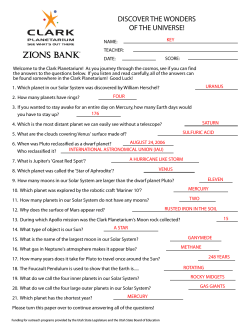
It is marvelous indeed to watch on television the
It is marvelous indeed to watch on television the rings of Saturn close; and to speculate on what we may yet find at galaxy’s edge. But in the process, we have lost the human element; not to mention the high hope of those quaint days when flight would create “one world.'” Instead of one world, we have '”star wars”, and a future in which dumb dented human toys will drift mindlessly about the cosmos long after our small planet's dead. Gore Vidal Arizona State University AST 111 Introduction to Solar Systems Astronomy Frank Timmes fxt.teaching@gmail.edu cococubed.asu.edu/class_pages/class_planet.shtml Chapter 11 - Jovian Planets - Learning Goals: A Wealth of Worlds: Satellites of Ice and Rock ‣What kinds of moons orbit the jovian planets? ‣Why are Jupiter’s Galilean moons so geologically active? ‣What is remarkable about Titan and other major moons of the outer solar system? ‣Why are small icy moons more geologically active than small rocky planets? What kinds of moons orbit the jovians? We can categorize the more than 100 known moons as small, medium, or large. Most of the medium and large moons probably formed with their planets in the disks of gas that surrounded their jovian planets when they were young. Smaller moons are often captured asteroids or comets. Why are Jupiter’s Galilean moons so geologically active? Io is the most volcanically active object in the solar system ... ... thanks to an interior kept hot by tidal heating - which occurs because Io’s close orbit is made elliptical by orbital resonances with other moons. Europa (and possibly Ganymede) may have a deep, liquid water ocean under its icy crust also thanks to tidal heating. Callisto is the least geologically active since it has no tidal heating or orbital resonances. What is about Titan and other major moons of the outer solar system? Many medium and large moons show a surprisingly high level of past or present volcanism or tectonics. Titan has a thick atmosphere and ongoing erosion. Triton, which apparently was captured by Neptune, also shows signs of recent geological activity. Why are small icy moons more geologically active than small rocky planets? Ices deform and melt at much lower temperatures than rock, allowing icy volcanism and tectonics at surprisingly low temperatures. In addition, some jovian moons have a heat source - tidal heating - that is not important for the terrestrial worlds.
© Copyright 2025












